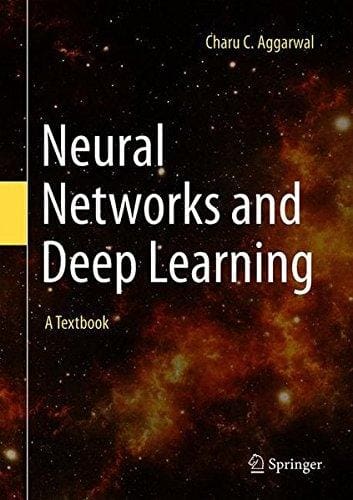 Neural Networks and Deep Learning: A Textbook
Neural Networks and Deep Learning: A Textbook
This book covers both classical and modern models in deep learning. The book is intended to be a textbook for universities, and it covers the theoretical and algorithmic aspects of deep learning.
Sponsored Post.

Neural Networks and Deep Learning, Springer, September 2018
Charu C. Aggarwal.
Comprehensive textbook on neural networks and deep learning: Table of Contents
Publisher book page (e-copy or hardcopy)
PDF download link for computers connected to subscribing institutions (free for subscribing universities and paywall for non-subscribers)
Book page with (latex) slides and power point figures for teaching
Length: 496 pages
The book "Neural Networks and Deep Learning: A Textbook" covers both classical and modern models in deep learning. The book is intended to be a textbook for universities, and it covers the theoretical and algorithmic aspects of deep learning. The theory and algorithms of neural networks are particularly important for understanding the important design principles of neural architectures in different applications. Why do neural networks work? When do they work better than off-the-shelf machine learning models? When is depth useful? Why is training deep neural networks so hard? What are the pitfalls? Even though the book is focused on an academic, textbook-like treatment of the subject (rather than being implementation-oriented), it is rich in discussing different applications. Applications associated with many different areas like recommender systems, machine translation, captioning, image classification, reinforcement-learning based gaming, and text analytics are covered. Concrete mathematical details are provided where needed. Numerous exercises are available along with a solution manual to aid in classroom teaching. In addition, PDF slides are available together with their latex source and the sources of the figures. The chapters of this book span three categories:
The basics of neural networks: Many traditional machine learning models can be understood as special cases of neural networks. An emphasis is placed in the first two chapters on understanding the relationship between traditional machine learning and neural networks. Support vector machines, linear/logistic regression, singular value decomposition, matrix factorization, and recommender systems are shown to be special cases of neural networks. These methods are studied together with recent feature engineering methods like word2vec.
Fundamentals of neural networks: A detailed discussion of training and regularization is provided in Chapters 3 and 4. Chapters 5 and 6 present radial-basis function (RBF) networks and restricted Boltzmann machines.
Advanced topics in neural networks: Chapters 7 and 8 discuss recurrent neural networks and convolutional neural networks. Several advanced topics like deep reinforcement learning, neural Turing machines, Kohonen self-organizing maps, and generative adversarial networks are introduced in Chapters 9 and 10.
The book is written for graduate students, researchers, and practitioners. Where possible, an application-centric view is highlighted in order to provide an understanding of the practical uses of each class of techniques.
Finally, the PDF version of this book contains links for navigation, and can be used on many platforms (including kindle). It is lower priced than kindle and is free for computers connected to subscribing universities at: https://rd.springer.com/book/10.1007/978-3-319-94463-0

 Neural Networks and Deep Learning: A Textbook
Neural Networks and Deep Learning: A Textbook